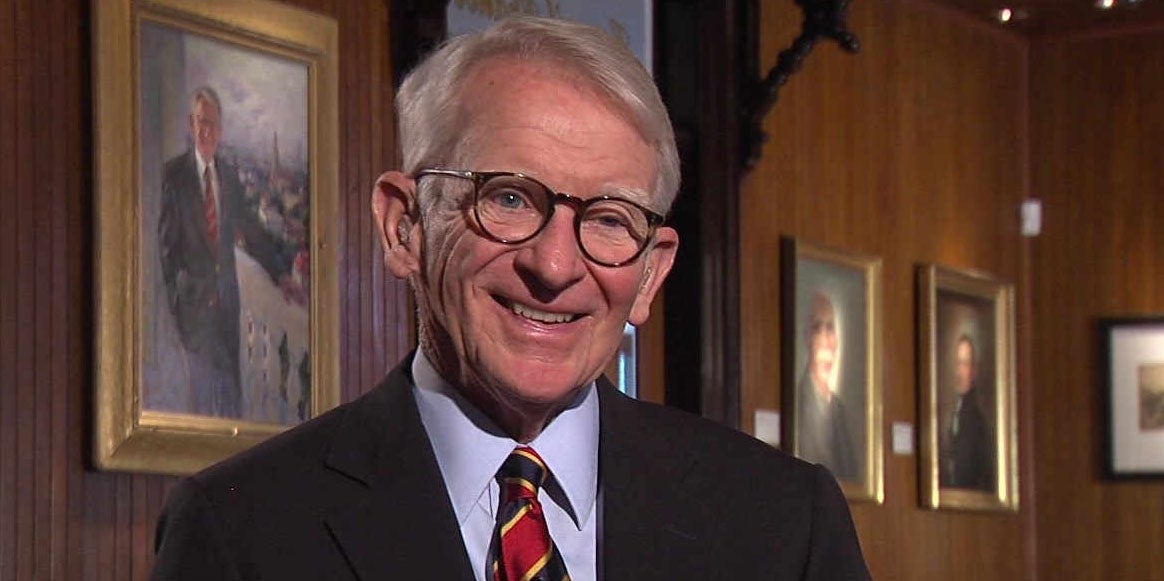Joe Riley has been mayor of Charleston since 1975, and over the span of four decades he’s had a profound impact on virtually every facet of life in the Holy City. Under his guidance and leadership, and in part due to his political acumen, Charleston has become a international tourism destination, a hub of culture and the arts, an economic powerhouse and a model for historic preservation and urban design.
The College Today asked five College of Charleston professors to weigh in on specific aspects of Riley’s legacy:
The Arts and Culture — Karen Chandler, director, Arts Management Program
Spoleto Festival USA will likely be identified as Mayor Riley’s signature contribution to the arts in Charleston. Riley and College of Charleston president Ted Stern were formative figures in getting Spoleto established. No doubt, this festival would not have happened without Mayor Riley’s active leadership, nor would the $1 billion economic impact that it generates for the city each year have been realized. But Spoleto was not this mayor’s only arts triumph.
Riley was also actively involved in establishing Piccolo Spoleto – the local-regional counterpart to Spoleto – and the African American and Caribbean arts festival, MOJA Arts Festival. He also spearheaded the renovation of the city’s gorgeous and acoustically advanced Gaillard Center. But his most recent and – what I believe will be his most definable cultural mark as mayor – is the proposed International African American Museum.
Mayor Riley’s arts and cultural legacy includes fostering smart urban design, public parks and other outdoor spaces. His work is most noted through his active leadership as the founder of the Mayors’ Institute on City Design. Riley’s vision and leadership have been acknowledged over the years by Americans for the Arts, a national arts organization that connects the arts, local communities and businesses. In 1999, he received the Public Leadership in the Arts Award that recognizes elected officials who advance the arts in their communities. In 2009, he was the National Medal of Arts Recipient, which is the highest award in the arts given by the U.S. government. And in 2010, Mayor Riley delivered the 23rd Annual Nancy Hanks Lecture on Arts and Public Policy.
The history of American arts leadership has Mayor Riley’s name and cultural achievements written in its annals. Those of us who call Charleston home, and those who visit here, are all the better for his vision, tenacity and unparalleled leadership in the arts.
The Economy — Frank Hefner, director, Office of Economic Analysis
Under the stewardship of Joe Riley, the economic landscape of Charleston has changed dramatically in the last 40 years. Four decades ago, Charleston was not the dynamic and vibrant city it is today. Of course, Charleston had its history. It had a relatively small tourist season. It had the Navy Base. And, apparently, not much else.
Early in his tenure, Riley pushed for the development of Charleston Place, which changed the retail landscape between Broad and Calhoun streets, and eventually led to the revitalization of upper King Street. To diversify and increase the tax base, he annexed Daniel Island into the city. Although not directly tied to jobs, quality of life and local ambience are very relevant to economic development in today’s technological and amenity-based economics. Riley spearheaded the additions of a semi-pro baseball park, the South Carolina Aquarium and Waterfront Park (now Riley Waterfront Park), which fit that mold.
Two potentially major events that could have stopped a lesser city and a lesser mayor were Hurricane Hugo and the Navy Base closing. The city not only survived those, but has grown robustly. Riley remains adamant that he didn’t accomplish this development on his own, but it’s true that he has provided the vision and leadership to put Charleston on the map internationally as a place to visit, live and prosper.
The Political Scene — Gibbs Knotts, chair, Department of Political Science
Mayor Joe Riley has led Charleston through some very difficult events, including Hurricane Hugo and the tragedy at Emanuel A.M.E. Church last summer. As a politician, he is recognized as a compassionate leader. Even though the mayor’s position is non-partisan, it is also noteworthy that Riley is one of last remaining white Southern Democrats. During his time in office, the city, state, and region has taken part in a dramatic shift from solidly Democratic to reliably Republican.
Riley will be remembered for being able to win elections with a bi-racial coalition of support. This was a common strategy for southern Democrats, particularly white southern Democrats during the 1970s and 1980s. However, that has become much less common in the South. In the case of congressional elections, redistricting created majority-minority districts and solidly Republican districts, decreasing the number of districts held by white Democrats. Riley’s ability to win support among black and white voters stands out, and it also helped him forge coalitions that are critical to successful governing.
Historic Preservation – R. Grant Gilmore, director, Historic Preservation Program
It is impossible to introduce the concept of historic preservation in America without discussing Charleston and the impact that Mayor Riley has had on the preservation community – locally, regionally, nationally and even internationally.
Riley’s vision for the City of Charleston has provided the most successful example to date for an unrivaled combination of urban planning/design and historic preservation in the U.S. This unique combination has allowed the College’s program in historic preservation to use the most lavishly equipped laboratory in the country every day for teaching – our city, or more accurately, Mayor Riley’s city – Charleston.
It’s clear that Mayor Riley’s influence in this realm stretches well beyond Charleston. Last May, the American Architectural Foundation recognized Riley’s many contributions in fostering sustainable urban design by awarding him its National Medal for Design Leadership.
Only six weeks later, President Obama appointed Riley to serve as a member of the Advisory Council on Historic Preservation. In that capacity, Riley will work with others to promote the preservation, enhancement and sustainable use of the nation’s diverse historic resources, and advise the president and Congress on national historic preservation policy.
Riley is also a founding member of the Mayors’ Institute on City Design, and it will surprise no one to learn that he intends to stay actively involved in the work of that body after he steps down from his mayoral duties.
Charleston History — Bernard Powers, associate chair, Department of History
Joseph P. Riley will be remembered as one of the most transformative mayors in Charleston’s lengthy history. In so many positive ways, he has left an indelible mark on this city, beginning with its revitalization, which can be seen in Charleston’s dramatic and stunning physical layout.
Though his signature contribution in economic development – Belmond Charleston Place – is mainly for the well-heeled or tourists, Riley has promoted numerous projects that give unusual access to the city’s public amenities, including Waterfront Park.
To achieve this record of accomplishment, Mayor Riley had to take significant risks, and one of the greatest challenges he faced in South Carolina has been on the racial front. He has boldly embraced such challenges. Many of us recall the Mayor’s leadership at the head of the march to Columbia in April of 2000 in an effort to bring down the Confederate flag. However, even before that I recall the firestorm of invective that was unleashed in 1976 when the mayor had Dorothy Wright’s portrait of Denmark Vesey installed in the then new Gaillard Auditorium. It was a bold decision to ensure that an important person – revered by black Charlestonians – had a public place of honor. Decades later, Riley put his imprimatur on the memorial to Denmark Vesey in Hampton Park, a project he fully supported.
Even at the end of his tenure Mayor Riley is placing his considerable talent and energy behind the effort to build the International African American Museum at Gadsden’s Wharf on the Cooper River. It is the kind of project that easily takes over one’s life and a mere politician with the Mayor’s long list of accolades and achievements could have readily passed on the additional work and responsibility.
Joseph P. Riley has been an exceptional leader who loves his city and realizes that until the African American component of the city’s history is told there will always be something missing. I am sure he will not rest until this latest project is completed and it will be a most fitting capstone to a career of devoted public service. His legacy will have positive effects for many generations to come.









